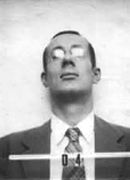Robert Cornog (1912-1998) was an American physicist and engineer.
When the United States entered World War II in 1941, Robert Cornog was working for the Navy on subsurface warfare and the development of ways to counter magnetic, undersea mines. In early 1942, Cornog left his Navy work for Princeton and joined the “Isotron” isotope separation project, working under Robert Wilson and Henry de Wolf Smyth. When the project was suspended in February 1943, Cornog went to Harvard to supervise the dismantling of their cyclotron.
In April of 1943, Cornog travelled to Los Alamos, where he was assigned to the Ordnance Division. He worked on the gun-type plutonium bomb, dubbed Thin Man, until that idea was scrapped. He also worked on neutron initiators, which provided a source of neutrons that would help start fission the moment a weapon was triggered. Cornog was put in charge of developing the “pumpkin” bombs that were used to simulate the Fat Man bomb for training missions, for the remainder of his time at Los Alamos. He also witnessed the Trinity test.
Later Years
Cornog quickly decided that nuclear weapons were a serious danger to the world and became involved with the Association of Los Alamos Scientists, which brainstormed solutions to nuclear policy issues. He took a job at Northrop Aircraft and worked on designing a nuclear powered aircraft, as well as the Snark, a rocket-boosted, jet powered, intercontinental missile. In 1947, Cornog was forced to leave Northrop, because his security clearance had been revoked due to possible communist associations.
During the 1950s, after getting his security clearance back, Cornog continued to work in the aerospace sector. In the 1960s, he switched to working on high vacuum systems, a field in which he worked until his retirement. Cornog passed away in Santa Monica, CA in 1998.





